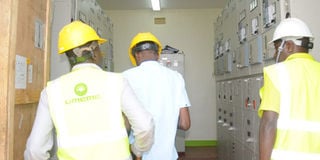Cabinet considers cutting power tariffs

Umeme says government needs to look at long-term solutions such as subsides or ensuring massive consumption instead of knee-jerk solutions. FILE PHOTO
Kampala- Cabinet is discussing ways through which it can lower power tariffs to five US cents per kilowatt for small scale industries engaged in value addition.
Speaking on the sidelines of the launch of new Umeme offices in Kiboga District, Ms Ruth Nankabirwa, the government chief whip, said Cabinet is considering a uniform tariff for both extra-large industries and small scale industries in value addition.
“We had reduced the tariff for only big industries but when we discussed the budget framework paper recently, we took a decision to take on every industry in value addition to enjoy the new tariff which will be five US cents,” she said.
The discussion, she said, came after consistent pleas from small scale manufacturers to reduce power tariff, saying it is a major deterrent to industrialisation.
However, Mr Selestino Babungi, the Umeme managing director, said for government to reduce tariffs to five US cents, power consumption would need to be enlarged.
“You cannot just knee jerk around and say you want five US cents. You need to sell this power massively to be able to spread the cost around,” he said, adding that government would as an alternative need to offer subsidies to enlarge consumption.
Electricity Regulatory Authority (ERA) last year reduced power tariffs for extra-large industries to five US cents per kilowatt hour after renegotiating the Bujagali debt refinancing.
The average monthly capacity payments to Bujagali Energy Limited, the contractor in charge of the dam, reduced from $13m (Shs48.5b) to $10m (Shs37.3b).
The move was well received by manufacturers who said if implemented, it will encourage production thus boosting the exports market.
“Five US cents is competitive because it takes into consideration the inefficiencies we have as a country. This will spur more productivity,” Mr Daniel Birungi, the Uganda Manufacturers Association executive director, said.
According ERA, the average cost of power at which generating companies sell to government is eight US cents.
Already, government has put in place strategies such as the free electricity connection policy, which are envisaged to add over 300,000 customers annually and three million in 10 years.
The policy seeks to reach a 60 per cent electricity access rate by 2027.
In 2018, Umeme connected more than 130,000 new customers consuming power worth Shs9b with the help of donor funded projects such as the output-based aid, which mainly focuses on free electricity connection for customers.
The increasing power connections have in the process created new opportunities with Umeme requiring more than 400 technicians ahead to manage the current demand as well as preparing for those ahead.
Additional power
With Uganda hoping to launch a number of dams such as Karuma and Isimba this year, according to Mr Babungi, there could be a possibility of lowering tariffs as more power will be evacuated to the national grid.
However, demand for power, which is currently at 10 per cent, will need to increase through industrialization.
A new 132KV transmission substation was commissioned last year with two generators with combined capacity of 80MVA to supply Hoima and Kiboga among others.
However, Hoima’s power demand is only 8 megawatts consuming only 10 per cent of the power transmitted in the region. Mr Babungi said there is need to increase industrial usage to consume surplus power across Uganda.




